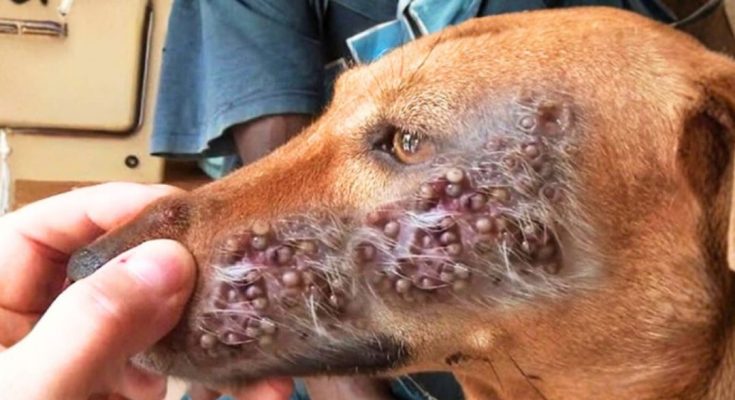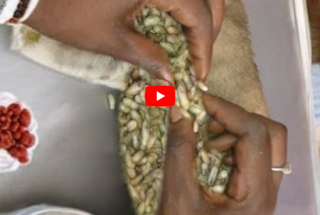
Dogs are vulnerable to a variety of parasites, but two that often alarm pet owners the most are mango worms and botflies. These parasites can burrow into a dog’s skin and cause painful swelling, infection, and discomfort. While both conditions involve larvae developing beneath the skin, they differ in geography, transmission, symptoms, and severity. Understanding these differences is essential for early detection, proper treatment, and prevention.
What Are Mango Worms?
Mango worms, also known as Cordylobia anthropophaga or African tumbu fly larvae, are parasitic larvae commonly found in parts of sub-Saharan Africa. Dogs become infected when the adult fly lays eggs on soil, clothing, bedding, or surfaces contaminated with urine or feces. When a dog lies on or comes into contact with these eggs, the larvae penetrate the skin and settle just beneath the surface.
Once inside the skin, the larvae create a small pocket where they grow. Over the course of several days to weeks, they produce swollen bumps that resemble boils, each with a tiny breathing hole in the center. These bumps are extremely painful and itchy for the dog.
What Are Botflies?
Botflies, specifically the Cuterebra species, are more common in North America, especially in warm, humid climates and areas with high rodent populations. Cuterebra flies normally target rodents and rabbits, but dogs can become accidental hosts when they sniff or explore burrows or areas contaminated with eggs.
Like mango worm larvae, botfly larvae enter through skin openings—often the mouth, nose, or wounds. Once under the skin, they develop inside a warble, which is a lump containing the larva. The warble typically has a small central hole used for breathing.
Symptoms of Mango Worm and Botfly Infestation
While each type of parasite has unique characteristics, both create visible, often painful skin lesions. Common symptoms include:
- Raised, red bumps resembling boils
- A visible hole in the center of each bump
- Thick, white or yellow discharge
- Swelling and inflammation
- Excessive licking or scratching
- Pain when touched
- Hair loss around the lesion
- Lethargy or behavioral changes in severe cases
Infections may also occur if bacteria enter the open wound, making prompt treatment essential.
How Vets Diagnose the Infestation
Diagnosis is usually straightforward based on visual inspection. The characteristic breathing hole and movement beneath the skin indicate a larval infestation. In rare cases, especially when the larva is deeper, an ultrasound or magnification may help locate it. Vets must determine whether the bump is caused by a parasite, an abscess, or another type of cyst before removing it.
Treatment: Safely Removing the Larvae
Removing mango worms or botfly larvae should always be done by a veterinarian. Proper technique is crucial to avoid rupturing the larva, which can lead to severe inflammation or secondary infection.
Veterinary Removal Procedure
- Sedation or local anesthesia may be used to reduce discomfort.
- The area is cleaned and disinfected.
- The vet applies gentle pressure around the breathing hole, coaxing the larvae out intact.
- Sometimes forceps or a specialized tool help extract stubborn larvae.
- The wound is flushed thoroughly to remove debris.
- An antibiotic ointment or medication is applied to prevent infection.
- Pain relievers or oral antibiotics may be prescribed, depending on severity.
Never attempt to squeeze out the larva at home. Improper removal increases the risk of complications.
Possible Complications
While mango worms and botflies are rarely life-threatening, untreated infestations can cause:
- Severe bacterial infections
- Tissue damage
- Abscess formation
- Systemic illness in extreme cases
- Prolonged pain and stress
Prompt veterinary care minimizes these risks.
Prevention Tips for Pet Owners
Preventing infestation is easier than treating it. The risk varies based on climate and environment, but general preventive steps include:
For Areas With Mango Worms (Africa)
- Wash and iron dog bedding regularly—heat kills eggs.
- Avoid letting pets roam in areas with contaminated soil.
- Keep sleeping areas clean and dry.
- Use dog-safe insect repellents if recommended by a vet.
For Areas With Botflies (North America)
- Keep dogs away from rodent burrows or nests.
- Reduce rodent activity near your home.
- Inspect your dog’s skin regularly, especially after outdoor play.
- Groom your dog frequently to spot skin abnormalities early.
When to Contact a Veterinarian
Seek veterinary assistance immediately if you notice:
- Large, painful bumps with central holes
- Movement inside the lesion
- Pus or foul odor
- Fever, lethargy, or behavioral changes
- Multiple bumps appearing rapidly
Early intervention ensures a quicker recovery and less discomfort for your dog.
Final Thoughts
Mango worms and botflies can be distressing for both dogs and their owners, but with proper knowledge, these parasitic infestations are entirely manageable. Understanding the symptoms, seeking timely veterinary care, and taking preventive measures can significantly reduce the risk. Since geography plays a major role in exposure, owners living in or traveling to high-risk regions should be especially vigilant. With the right care and attention, dogs can recover quickly and return to their happy, healthy lives.



